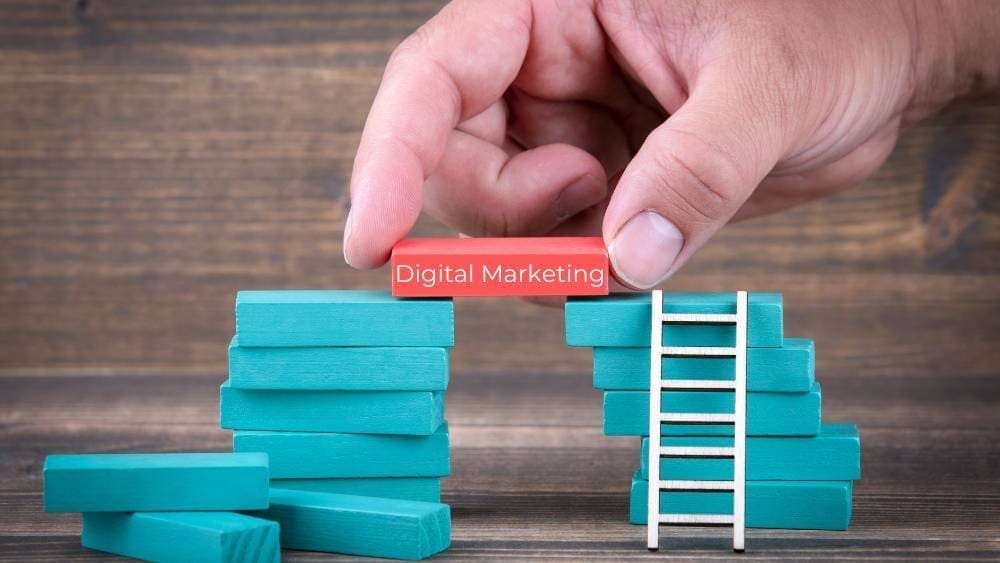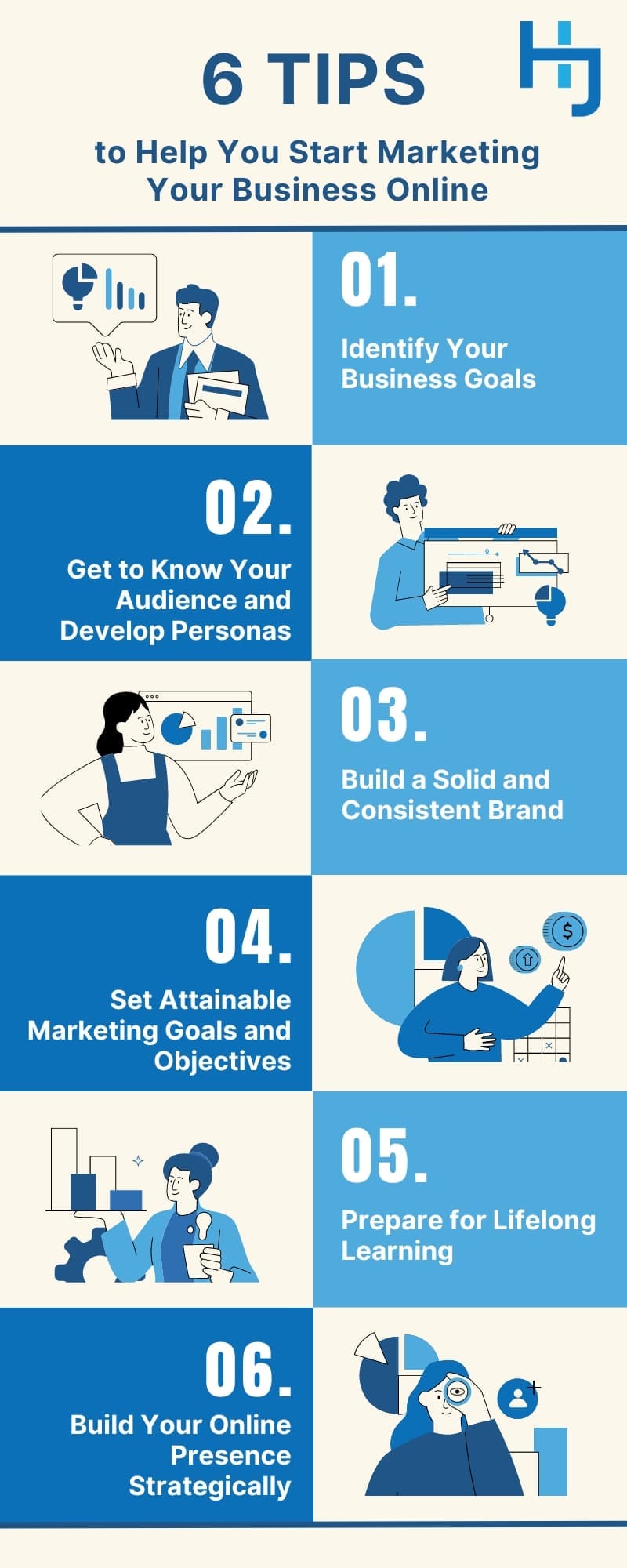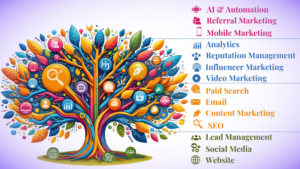
Business owners I speak with often want to know how to start digital marketing. They ask about websites, social media, SEO, and everything in between. I’ll tell you a secret: that’s not where you should start. If you’re serious about it and want to prime your engine for success, you need to begin with digital marketing foundations. These aren’t traditional digital marketing activities that bring you new clients on their own, but they will ensure your later initiatives perform much better and your company grows stronger as a whole.
Give me a few minutes, and I’ll walk you through digital marketing tips that nobody talks about that can make or break your results and explore how to prime your initiatives for success by laying strong digital marketing foundations first.
How is Digital Marketing Different from Traditional Marketing
Before we dig into the foundations of digital marketing, let’s quickly compare how digital marketing works to traditional marketing and the various channels involved.
What Are the Top 8 Traditional Marketing Channels?
Even though digital marketing tends to be top of mind for most business owners, traditional marketing channels still produce 56 percent of advertising revenue per MailChimp research. A few of the most popular channels are highlighted below.
1. Handouts
A traditional marketing handout is a one-page document focusing on a business’s key area. It’s not quite as detailed as a brochure and is typically used to complement another form of marketing. For instance, a handout is often provided after a speaking engagement. Sometimes handouts are included with email campaigns too.
2. Billboards
Given the amount of time people spend in their vehicles, billboards can be a good way to increase brand awareness. However, they can also be quite expensive, with a full-sized board costing $30,000 for four weeks, according to Blue Line Media.
3. Direct Mail
Postcards, catalogs, and letters also get a fair amount of use. Although these mediums are more effective with B2C audiences than B2B, the average B2B campaign still gets around a four percent response rate per PostGrid. Effectiveness climbs when paired with digital marketing.
4. Print Ads
Print ad revenue is declining overall, but print can boost the effectiveness of online campaigns by 400 percent, according to FinancesOnline.
5. Event Marketing
With 41 percent of marketers saying event marketing is the most crucial channel per Zippia, it’s no surprise that event marketing spend is growing in leaps and bounds. With that said, this bracket now includes virtual and hybrid events, which have increased exponentially in recent years.
6. Referral Marketing
A formal referral partner program can literally double a business’s sales. However, this, too, requires a hybrid approach. Programs are far more effective when referral partners are treated like prospects and customers, complete with digital nurturing campaigns, onboarding, and ongoing relationship building.
7. Broadcast Marketing
Radio and TV ads are still very popular, though the costs can be staggering. Radio tends to be more affordable, though a 30-second spot can easily exceed $1,000 in highly populated areas per Fit Small Business. Most broadcast marketing campaigns are paired with a call-to-action that involves a digital property, such as sending listeners to a business website.
8. Cold Calling
Just one to two percent of cold calls result in scheduling a meeting, according to Salesforce. Even fewer become deals or actual customers. Still, many businesses leverage cold calls as part of their overall strategy.
What Are the 7 Types of Digital Marketing?
Now that we’ve covered some of the most popular traditional marketing channels, let’s look at some common types of digital marketing.
1. Social Media Marketing
Social media is one of the most cost-effective ways of marketing a business online. I cover social media marketing in depth in “Why Social Media is Integral in Business Marketing,” but suffice it to say, most people are online, and it’s easy to reach thousands of people for pennies.
2. Search Engine Optimization (SEO)
Contrary to popular belief, search engine optimization (SEO) is not a single task or role. It’s a grouping of activities that helps a business appear in more online searches and appear higher in search results. This allows the website to attract more organic (unpaid) traffic, ultimately increasing the customer base. SEO includes activities like keyword and competitor research, analytics, link optimization, and content marketing.
3. Content Marketing
Blogs, case studies, infographics, social media, videos, and more can all fall under the umbrella of content marketing. In addition to boosting SEO, high-quality content marketing impacts decision-making more than any other strategy, according to HubSpot research. Simply put, quality content shows that the business is a subject matter expert, builds trust, and engages readers in a way no other medium can touch.
4. Email Marketing
Often included in the content marketing umbrella, email marketing returns an average of $44 for each $1 spent, according to Campaign Monitor. There are many email marketing strategies businesses can leverage, including welcome or onboarding messages, newsletters, and re-engagement campaigns. This makes it one of the most versatile types of marketing, and also the easiest to personalize.
5. Influencer Marketing
Brands can gain $5.20 for each $1 spent on influencer marketing, Shopify reports. A strong influencer marketing strategy increases brand awareness and reach, boosts sales, and can even impact SEO, among other things.
6. Paid Advertising
Whereas SEO tends to be a long-term strategy that takes time to build, pay-per-click (PPC) ads can generate leads immediately. However, campaigns need to be managed by an expert to ensure that they’re targeting the right audience at the right time with the right message to be cost-effective.
7. Affiliate Marketing
Affiliate marketing is somewhat of a hybrid between paid advertising and referral marketing. The referring source places a link to the business site on its web property. The publisher/ affiliate usually receives payment each time someone clicks the link, though some affiliate programs only pay out when a sale is made. It differs from a referral program in that there isn’t usually a personal relationship between the affiliate and the business or the affiliate and its readers. For this reason, it tends to work better for B2C product marketing as opposed to B2B services.
What Are the 5 Ps of Digital Marketing?
As part of your prep work before you begin working on the digital marketing foundations, it’s important to familiarize yourself with the five Ps of digital marketing as they relate to your brand.
1. Product
The features, functionality, and benefits of your services or products and packaging all fall under the “product” umbrella.
2. Price
Consider how you structure the price of your products or services, including overall costs, discounts, and payment arrangements.
3. Promotion
“Promotion” refers to activities and methods you plan to use to promote your products or services. They’re typically determined after an ROI analysis.
4. Place
The “place” includes how you plan to deliver goods or services, including distribution channels, service levels, logistics, etc.
5. People
Everyone involved, including your team and customers, falls into the “people” category. Consider what it will take to market and sell your product or service and support customers’ needs after a sale to build loyalty.
Marketing Your Business: Digital Marketing vs. Traditional Marketing
Traditional marketing tends to work better when businesses want to cast a wide net and reach lots of people with different backgrounds all at once. It can also boost the effectiveness of digital marketing activities. Conversely, digital marketing is ideal for those who want a more targeted approach and for those looking to maximize ROI.
Why You Need Digital Marketing for Your Business 
Before we get into tips for digital marketing, let’s do a quick recap of the benefits. Digital marketing is better for:
- Creating seamless user experiences
- Targeting personas
- Engaging audiences
- Building and strengthening relationships
- Crafting dynamic campaigns that can be adjusted for effectiveness as needed
- Conversion
- Creating measurable results
- Analyzing return on marketing investment (ROMI)
Digital Marketing Tips to Help You Start Marketing Your Business Online
Now that we’ve covered the basics, let’s dig into how to start marketing your business. Before you begin any campaigns, you must nail the digital marketing fundamentals. In doing so, any marketing initiatives you launch later will be structured to lead to better outcomes. Some tips for business marketing that set the stage for success are covered below.

1. Identify Your Business Goals
Many businesses start with basic digital marketing activities with little more than the idea that it’s something they should be doing or can help the brand somehow. That’s not enough. It’s like getting in the car and deciding to take the freeway but not knowing where you want to go, let alone how you’ll actually get there. You’re just driving and hoping for the best. It’s theoretically possible to reach an ideal destination, but odds are, you will wind up out of gas on the side of the road instead.
When you start with your business goals, you know your destination. That means you can map out the best route to get there, use your fuel efficiently, and find ways to identify if you’re on track to get to where you want to go.
Let’s use social media as an example. Many businesses start by creating a Facebook page. Some may even measure engagement. But what’s the benefit of engagement, who do you want to engage with your brand, and are you using the most effective methods to build the type of engagement you want? You don’t know if you don’t start with your business goals.
In this case, the goal might be to increase brand awareness, reduce customer churn, and boost loyalty. You know where you’re going, but what’s the best route? If your goal is to reduce customer churn and boost loyalty, then you might want to focus on the customer service aspects of Facebook. You’ll be more likely to post tips your existing customers will appreciate and may dedicate more resources to operating the chat. Conversely, if your goal is to boost awareness, maybe you’ll work more with trending hashtags, encourage more tagging and engagement from your current customers, or run more contests.
This is only one channel and one activity. Every digital marketing activity your team engages in needs the same approach. Before you do anything else, start with the business goals.
2. Get to Know Your Audience and Develop Personas
The average person receives more than 120 emails per day, according to Campaign Monitor. They also see up to 10,000 ads each day, Zippia reports. With this kind of noise around people all day long, it takes a lot to get someone’s attention. The best way to do that is by being where they are and creating messages that speak directly to them.
To do this, you can begin with basic target audiences. For instance, you may know that the group of people most likely to use your products or services are white-collar professionals between the ages of 30 and 50. Maybe you can even whittle it down by gender and industry. That might be enough to help you identify which channels your potential customers are likely to use or even refine your ads to ensure only probable buyers see them. However, it only helps put your business on the same road as your prospective clients. It doesn’t necessarily help ensure they notice you or tell you what matters to them. That’s why you need buyer personas too.
A persona is a fictional person who represents one of your customers. He has a name, a job, and hobbies. You know which websites he uses and what he wants to accomplish. You understand what he’s looking for when he makes a purchase, what he’s struggling with, and what might stop him from moving forward with your company. You can’t really talk to an audience in a meaningful way, but you can talk to “Peter,” the head of recruitment at Acme Corporation. If you know Peter well, you can create messaging that speaks to him everywhere, including via ads, social media, and email. That means your messages are going to be seen by Peter and resonate with him. Because he has the same familiar experience everywhere, he will start thinking of your company as a “friend.”
3. Build a Solid and Consistent Brand
Returning to our trip analogy, you can think of branding as your vehicle. The type of car you’re driving will determine whose eyes are drawn to you while you’re on the road. It can impact the efficiency with which you reach your destination too. If you’re constantly changing your vehicle, even your friends will have difficulty recognizing you. You might also start with a Ferrari and wind up with a Gremlin duct-taped together at the end. Nothing else you do on the trip matters if your vehicle falls apart or becomes unrecognizable during the journey.
In this sense, branding isn’t just your logo or design elements. That’s like saying a Ferrari and a Gremlin are the same cars as long as they’re both red. Instead, branding should be considered broadly. It’s the ethos of your company, the philosophies you believe in, the personality that comes through each time your business communicates, and the service you deliver. Great branding helps build recognition with customers and creates bonds. For this reason, branding is even more important than SEO.
Start with clear brand guidelines that include everything that makes up its personality. Then, distribute your brand guidelines to everyone involved in your digital marketing. That way, it won’t matter who’s behind the wheel or which road the person’s on. Instead, the vehicle will look and feel familiar to all the friends you make along the journey.
4. Set Attainable Marketing Goals and Objectives
At this stage in the digital marketing foundations, you know where you’re going, the route you want to take, and the friends you want to make along the way. But how will you know when you’ve arrived at your destination or if you’re even on track to get there? You need goals and objectives that are specific to digital marketing too.
Let’s go back to our social media example and work with the idea that our overreaching goal is to increase brand awareness. We must then consider the platform and identify how we can measure whether we’re increasing brand awareness via the channel. This is Facebook, so we might decide to measure page likes or reach. We might also consider how many people from Facebook visit our website.
Once we know which metrics we’re measuring and set a clear goal, it’s easy to see if we’re on the right track as we travel, and we’ll know for sure when we reach our destination. Perhaps more importantly, we can identify the best ways to reach our goals. If, for instance, we’re using page likes as our measuring stick, we might run a contest that requires a like to enter. If we’re measuring clicks through to our site, we might, instead, focus more on creating interesting content on our website that gets shared and liked via Facebook.
5. Prepare for Lifelong Learning
As the saying goes, “Change is the only constant.” Technology evolves. Audience interests shift. A medium that’s effective today may not be useful tomorrow. Something your audience disliked yesterday may be their favorite thing tomorrow.
It’s important to keep learning and adapting your strategy to ensure you’re working with whatever’s most effective today. Furthermore, good marketers never use a “set it and forget it” mindset. They’re experimenting with new ideas and running A/B tests to see if results can be improved.
6. Build Your Online Presence Strategically
Your marketing plan should be staggered. Begin with the digital marketing foundations covered here, and don’t move forward until you nail them. Then, move into “ground fruit” activities. That way, each initiative begins on firm ground, and future initiatives have better odds of success and improve the results you’re getting in earlier initiatives too.
Get Help Shoring Up Your Digital Marketing Foundations
As a business and digital marketing consultant, I work very closely with my clients in the early stages to understand how the company works and its overall objectives so that all future initiatives truly feed into positive business outcomes. I also address areas like branding and personas as initial activities to give all future digital marketing efforts a consistent feel and approach, which makes initiatives more successful. If your digital marketing isn’t getting the results it should, or your foundations need some shoring up, please contact me for a complimentary consultation.




































































